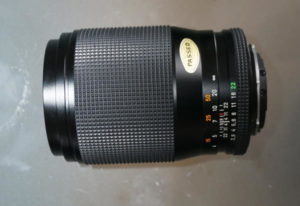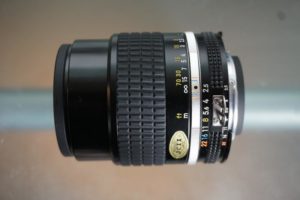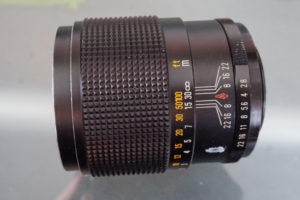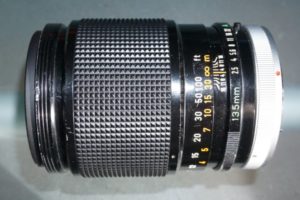Bokeh has been defined as “the way the lens renders out-of-focus points of light”. Bokeh occurs for parts of the scene that lie outside the depth of field. You can get more information about bokeh here: https://tech-reviews.swiss-1.ch/vintage-lenses-prime/#bokeh
Click here to: VIEW GALLERY OVERVIEW
[ngg src=”galleries” ids=”12″ display=”basic_thumbnail”]Click here to: VIEW GALLERY OVERVIEW
Comparing the bokeh of 2 affordable and 2 budget classic lenses
Two affordable and two budget classic lenses were used to compare their very distinct bokeh:
- Carl Zeiss T* Sonnar C/Y 135mm f2.8 (van Gogh Bokeh) for approx. EUR 230 on ebay, made in 1989
- Nikon Nikkor Ai-S 105mm f2.5 (Burning Bokeh) for approx. EUR 280 on ebay, made in 1984
- Raynox M42 135mm f2.8 (Wet-on-Wet Bokeh) for approx. EUR 30 on ebay, made in the 1970s
- Canon S.C. FD 135mm f2.5 (Creamy Bokeh) for approx. EUR 90 on ebay, made in 1978
The classic lenses can be identified in the gallery by the filename. All bokeh photos were shot on similar image compositions with sunflowers as background. Bokeh evaluations are always subjective, so please consider my comments as my personal opinions, for your reference.
Carl Zeiss T* Sonnar C/Y 135mm f2.8: van Gogh Bokeh

The T* multi-coated Carl Zeiss Sonnar lens is a distant descendant of the famous Olympia Sonnar from 1936 with a Contax/Yashica mount:
Typically, Sonnar types of lenses are well known for their creamy bokeh, but this lens also shows some characteristics of a van Gogh Bokeh in the Sunflower photos. Get more information about a van Gogh Bokeh here:
Unfortunately, this lens has a long minimum focus distance of 1.6 meters, which makes it difficult to shoot the bees more closely. The lens has a built-in lens hood.
Get more information about this lens here: https://contax-cameras.reconact.com
Nikon Nikkor Ai-S 105mm f2.5: Burning Bokeh

The first Nikkor 105mm f2.5 lens was released in 1959 by Nikon as a Sonnar type of lens and has a perfect creamy bokeh. In 1971, the lens type changed to a super-sharp Xenotar with a not-so-pleasing “burning bokeh”. The lens used here is from 1984 and is the exact same model that Steve McCurry used to shoot the iconic portrait photo of the Afghan girl with the green eyes:
Afghan Girl with the Green Eyes and the Nikkor Ai-S 105mm f2.5 lens
The minimum focus distance is only 1.0 meter long. This makes it easy to shoot the bees more closely. The lens has a built-in lens hood. See some photos shot in India, in 2019, with the Nikkor Ai-S 105mm f2.5 and the “Burning Bokeh” here:
Find more information about this lens here: https://tech.swiss-1.ch/Nikkor-105
Raynox M42 135mm f2.8: unique Wet-on-Wet Bokeh

According to Karl Havens, host of the Classic Lenses Podcast, this Raynox lens renders its bokeh like no other lens.
This classic lens was selected as recommended 135mm budget lens by Simon Forster, another host of the Classic Lenses Podcast. The bokeh of the Raynox M42 135mm f2.8 vintage lens corresponds to the wet-on-wet technique for watercolor paintings, adding wet paint onto wet paper, and allowing the added pigment to spread out unhindered:
There was a long controversy of lovers and haters of this lens, especially from Johnny Sissons from Chicago, one of the hosts of the Classic Lenses Podcast:
Telegram to Johnny: Sharpness turned up in shots with “The Butter Knife” Raynox 135mm lens
The minimum focus distance is as long as with the Carl Zeiss Sonnar. The lens has no built-in lens hood.
Get more information about this lens here: https://tech.swiss-1.ch/Raynox
Canon S.C. FD 135mm f2.5: Creamy Bokeh

The Canon S.C. (Spectra Coating) FD lens is a good performer for its price and a technical predecessor of the Lord of the Red Rings 135mm f2 UMC L-lens. The bokeh makes us believe that the Canon lens should be a Sonnar type lens. This lens has a minimum focus distance of 1.3 meters, and has a built-in lens hood. This lens also exists in an older version without Spectra Coating.
Find more information about the famous Canon descendant lens here, The “Lord of the Red Rings” Canon EF 135mm L-lens:
Get more information about this lens here: http://forum.mflenses.com
Learning: The shooting of nice bokeh photos with sunflowers and approaching bees takes more effort than expected
 You have to make several things happen at the same time:
You have to make several things happen at the same time:
- You have to find a large field of sunflowers with many sunflowers growing together.
- You need good weather and it must be pre-noon sunshine, otherwise the light will come from the side or back onto the sunflowers. As soon as there is a cloud between the sun and the sunflowers you can stop shooting.
- The sunflowers have to be large in size and at the right blooming phase to attract many bees.
- You need the right prime lens with a good sharpness and a pleasing bokeh. Except the classic Nikkor Ai-S 105mm f2.5 Xenotar type lens, all other classic lenses used in this review are good lenses for such photos.
- Use a lens aperture of f4 or f5.6. Apertures below f4 are problematic because the depth of field is too shallow to get a bee and a sunflower in focus at the same time. Apertures above f5.6 will ruin your bokeh.
- A camera with a fast shooting frequency of about ten frames per second is optimal, otherwise you will miss many good bee shots.
- It is a challenge to get a good photo composition with a cooperative bee approaching a sunflower in the foreground and sunflowers in the background to provide a pleasing bokeh.
- It requires stamina and enough patience to wait for the right moment when a bee approaches the sunflower in focus.
Leave your comments!
Do you have a different view on the bokeh ratings, like or dislike the Bees and Sunflowers photo shots? Your comments are welcome.
Thanks!